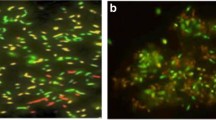Abstract
Microband biosensors were fabricated from a screen-printed water-based carbon ink containing cobalt phthalocyanine redox mediator and glucose oxidase or lactate oxidase enzyme. The microbiosensors were characterised for their ability to monitor ferrocyanide and H2O2 in phosphate buffer solution: sigmoidal cyclic voltammograms, high current density values and steady-state amperometric responses confirmed the existence of radial-diffusion-limiting microelectrode behaviour. The lactate microband biosensors were then used, in conjunction with a screen-printed Ag/AgCl reference and platinum counter electrode, to monitor lactate levels in culture medium, with a linear range of 0.5–5 mM, sensitivity of 20 nA.mM−1, and dynamic range up to >9 mM. The lactate microband biosensors could operate continuously in culture medium over extended times (up to 24 h) at 37 °C. These biosensors were then applied to detect changes in lactate release from cultured cells in response to toxic challenge: m-dinitrobenzene (500 μM) caused a reduction in lactate production by high-passage number HepG2 single cells; D-galactosamine (20 mM) induced release of lactate by HepG2 spheroid cultures. This novel use of microband biosensors in cell culture has the potential for further application in toxicity monitoring, in both environmental and pharmaceutical areas.






Similar content being viewed by others
References
Ahmad A, Moore EJ (2009) Comparison of cell-based biosensors with traditional analytical techniques for cytotoxicity monitoring and screening of polycyclic aromatic hydrocarbons in the environment. Anal Lett 42:1–28
Xu J, Purcell WM (2006) Energy metabolism and biotransformation as endpoints to pre-screen hepatotoxicity using a liver spheroid model. Toxicol Appl Pharmacol 216:293–302
Pemberton RM, Pittson R, Biddle N, Hart JP (2007) Fabrication of microband glucose biosensors using a screen-printing water-based carbon ink and their application in serum analysis. Biosens Bioelectron 24:1246–1252
Rawson FJ, Purcell WM, Xu J, Pemberton RM, Fielden PR, Biddle N, Hart JP (2009) A microband lactate biosensor fabricated using a water-based screen-printed carbon ink. Talanta 77:1149–1154
Pemberton RM, Xu J, Pittson R, Biddle N, Drago GA, Jackson SK, Hart JP (2009) Application of screen-printed microband biosensors to end-point measurements of glucose and cell numbers in HepG2 cell culture. Anal Biochem 385:334–341
HSDB (2002) Hazardous Substances Data Bank: 1, 3-Dinitrobenzene. National Library of Medicine, Bethesda
EPA US (1989) U.S. Environmental Protection Agency 40 CFR Part 372, community right-to-know release reporting; addition of certain chemicals; proposed rule. Fed Regist 54:16138–16142
Plaa GL (1991) Toxic response of the liver. In: Amdur MO, Doull J, Klaassen CD (eds) Casarett and Doull’s toxicology, 4th edn. Pergamon, NY, p 334
Xu J, Ma M, Purcell WM (2003) Characterisation of some cytotoxic endpoints using rat liver and HepG2 spheroids as in vitro models and their application in hepatotoxicity studies. II. Spheroid cell spreading inhibition as a new cytotoxic marker. Toxicol Appl Pharmacol 189:112–119
Crouch E, Cowell DC, Hoskins S, Pittson R, Hart JP (2005) Amperometric, screen-printed, glucose biosensor for analysis of human plasma samples using a biocomposite water-based carbon ink incorporating glucose oxidase. Anal Biochem 347:17–23
Xu J, Ma M, Purcell W (2003) Characterisation of some cytotoxic endpoints using rat liver and HepG2 spheroids as in vitro models and their application in hepatotoxicity studies. I. Glucose metabolism and enzyme release as cytotoxic markers. Toxicol Appl Pharmacol 189:100–111
Trinder T (1969) Determination of glucose in blood using glucose oxidase with an alternative oxygen acceptor. Ann Clin Biochem 6:24–27
Wang J (2006) Chapter 4: practical considerations. In: Wang J (ed) Analytical electrochemistry, 3rd edn. Wiley, USA
Gilmartin MAT, Hart JP, Patton DT (1995) Prototype, solid-phase glucose biosensor. Analyst 120:1973–1981
Rawson FJ, Purcell WM, Xu J, Cowell DC, Fielden PR, Biddle N, Hart JP (2007) Fabrication and characterisation of novel screen-printed tubular microband electrodes, and their application to the measurement of hydrogen peroxide. Electrochim Acta 52:7248–7253
Wilson K, Walker J (1994) Practical biochemistry, 4th edn. Cambridge University Press, New York
Hochachka PW, Somero GN (1984) Biochemical adaptation. Princeton University Press, Princeton
Morris JG (1974) The kinetics of enzyme-catalysed reactions. In: Barrington EJW, Willis AJ (eds) A biologist’s physical chemistry, 2nd edn. Edward Arnold, London, pp 312–317
Gurjral JS, Farhood A, Jaeschke H (2003) Oncotic necrosis and caspase-dependent apoptosis during galactosamine-induced liver in rats. Toxicol Appl Pharmacol 190:37–46
Funfak A, Cao J, Wolfbeis OS, Martin K, Kohler JM (2009) Monitoring cell cultivation in microfluidic segments by optical pH sensing with a micro flow-through fluorometer using dye-doped polymer particles. Microchim Acta 164:279–286
Acknowledgements
R.M.P. was funded by a Technology Strategy Board Micro & Nanotechnology project. The authors thank Leah Jones (A.E.T., Ltd) for help with screen-printing and Dr D. Patton (UWE) for electron microscopy.
Author information
Authors and Affiliations
Corresponding author
Rights and permissions
About this article
Cite this article
Pemberton, R.M., Rawson, F.J., Xu, J. et al. Application of screen-printed microband biosensors incorporated with cells to monitor metabolic effects of potential environmental toxins. Microchim Acta 170, 321–330 (2010). https://doi.org/10.1007/s00604-010-0326-0
Received:
Accepted:
Published:
Issue Date:
DOI: https://doi.org/10.1007/s00604-010-0326-0




